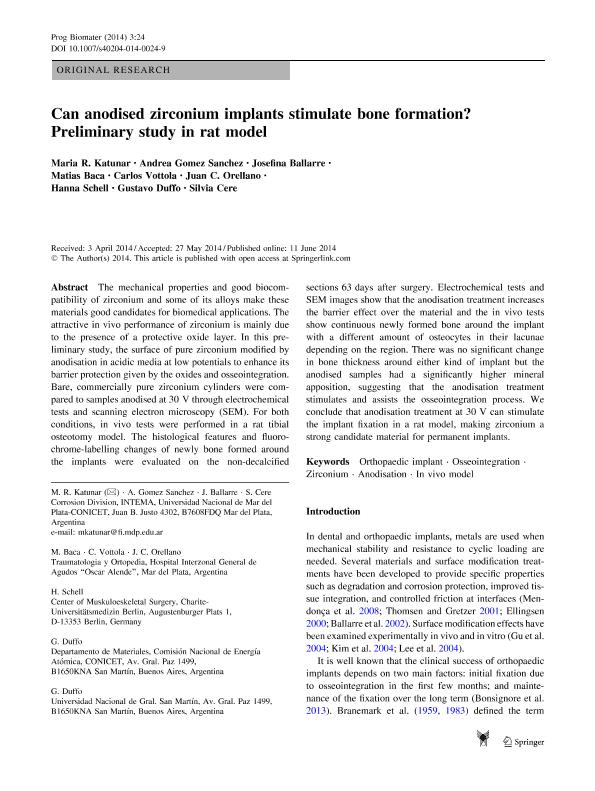Mostrar el registro sencillo del ítem
dc.contributor.author
Katunar, Maria Rosa

dc.contributor.author
Gomez Sanchez, Andrea Valeria

dc.contributor.author
Ballarre, Josefina

dc.contributor.author
Baca, Matías
dc.contributor.author
Vottola, Carlos
dc.contributor.author
Orellano, Juan C.
dc.contributor.author
Schell, Hanna
dc.contributor.author
Duffo, Gustavo Sergio

dc.contributor.author
Cere, Silvia

dc.date.available
2016-04-04T14:57:40Z
dc.date.issued
2014-06-11
dc.identifier.citation
Katunar, Maria Rosa; Gomez Sanchez, Andrea Valeria; Ballarre, Josefina; Baca, Matías; Vottola, Carlos; et al.; Can anodised zirconium implants stimulate bone formation? Preliminary study in rat model; Springer; Progress in Biomaterials; 3; 24; 11-6-2014; 1-10
dc.identifier.issn
2194-0517
dc.identifier.uri
http://hdl.handle.net/11336/5015
dc.description.abstract
Mechanical properties and good biocompatibility of zirconium and some of its alloys focus these materials as good candidates for biomedical applications. The attractive in vivo performance of zirconium is mainly due to the presence of a protective oxide layer. In this preliminary study, surface modification of pure zirconium was made by anodisation in acidic media at low potentials, enhancing the barrier protection given by the oxides and the osseointegration. Electrochemical and SEM (scanning electron microscopy) assays were done in commercially pure zirconium cylinders and two surface conditions were compared: pure and zirconium anodised at 30V. The in vivo assays were held in a tibia rat model. The histological features and fluorochrome labelling changes of newly bone formed around implants were evaluated on the non-decalcified sections 63 days after surgery. Electrochemical and SEM assays showed that anodisation treatment would increased the barrier effect over the material and the in vivo assays showed a continuous newly bone formation around the implant with a different amount of osteocytes in their lacunaes depending the region. There was no significant change in bone thickness around both kinds of implants but conversely a significant increase in the mineralization apposition rate was determined for the anodised condition suggesting that anodisation treatment would stimulate and assist to the osseointegration process. We conclude that anodisation treatment at 30 V can stimulate the implant fixation in a rat model and this study would propose the study of zirconium as candidate material for permanent implant.
dc.format
application/pdf
dc.language.iso
spa
dc.publisher
Springer

dc.rights
info:eu-repo/semantics/openAccess
dc.rights.uri
https://creativecommons.org/licenses/by/2.5/ar/
dc.subject
Bone
dc.subject
Fluorochoromes
dc.subject
Zr Implant
dc.subject
Osseointegration
dc.subject
Orthopaedic Implant
dc.subject
Zirconium
dc.subject
Anodisation
dc.subject
In Vivo Model
dc.subject.classification
Físico-Química, Ciencia de los Polímeros, Electroquímica

dc.subject.classification
Ciencias Químicas

dc.subject.classification
CIENCIAS NATURALES Y EXACTAS

dc.subject.classification
Biomateriales

dc.subject.classification
Biotecnología de la Salud

dc.subject.classification
CIENCIAS MÉDICAS Y DE LA SALUD

dc.title
Can anodised zirconium implants stimulate bone formation? Preliminary study in rat model
dc.type
info:eu-repo/semantics/article
dc.type
info:ar-repo/semantics/artículo
dc.type
info:eu-repo/semantics/publishedVersion
dc.date.updated
2016-05-06 15:52:43.262787-03
dc.journal.volume
3
dc.journal.number
24
dc.journal.pagination
1-10
dc.journal.pais
Alemania

dc.journal.ciudad
Berlín
dc.description.fil
Fil: Katunar, Maria Rosa. Consejo Nacional de Investigaciones Científicas y Técnicas. Centro Científico Tecnológico Mar del Plata. Instituto de Investigación En Ciencia y Tecnología de Materiales (i); Argentina. Universidad Nacional de Mar del Plata. Facultad de Ingeniería; Argentina
dc.description.fil
Fil: Gomez Sanchez, Andrea Valeria. Consejo Nacional de Investigaciones Científicas y Técnicas. Centro Científico Tecnológico Mar del Plata. Instituto de Investigación En Ciencia y Tecnología de Materiales (i); Argentina. Universidad Nacional de Mar del Plata. Facultad de Ingeniería; Argentina
dc.description.fil
Fil: Ballarre, Josefina. Consejo Nacional de Investigaciones Científicas y Técnicas. Centro Científico Tecnológico Mar del Plata. Instituto de Investigación En Ciencia y Tecnología de Materiales (i); Argentina. Universidad Nacional de Mar del Plata. Facultad de Ingeniería; Argentina
dc.description.fil
Fil: Baca, Matías. Hospital Interzonal General de Agudos ‘‘Oscar Alende’’. Mar del Plata; Argentina
dc.description.fil
Fil: Vottola, Carlos. Hospital Interzonal General de Agudos ‘‘Oscar Alende’’; Argentina
dc.description.fil
Fil: Orellano, Juan C.. Hospital Interzonal General de Agudos ‘‘Oscar Alende’’. Mar del Plata; Argentina
dc.description.fil
Fil: Schell, Hanna. Universitatsmedizin Berlin; Alemania
dc.description.fil
Fil: Duffo, Gustavo Sergio. Comision Nacional de Energia Atomica. Gerencia D/area de Energia Nuclear. Unidad de Actividad de Materiales (cac); Argentina. Universidad Nacional de San Martín; Argentina
dc.description.fil
Fil: Cere, Silvia. Consejo Nacional de Investigaciones Científicas y Técnicas. Centro Científico Tecnológico Mar del Plata. Instituto de Investigación En Ciencia y Tecnología de Materiales (i); Argentina. Universidad Nacional de Mar del Plata. Facultad de Ingeniería; Argentina
dc.journal.title
Progress in Biomaterials
dc.relation.alternativeid
info:eu-repo/semantics/altIdentifier/issn/2194-0517
dc.relation.alternativeid
info:eu-repo/semantics/altIdentifier/doi/10.1007/s40204-014-0024-9
dc.relation.alternativeid
info:eu-repo/semantics/altIdentifier/doi/http://dx.doi.org/10.1007/s40204-014-0024-9
dc.relation.alternativeid
info:eu-repo/semantics/altIdentifier/url/http://link.springer.com/article/10.1007%2Fs40204-014-0024-9
Archivos asociados
